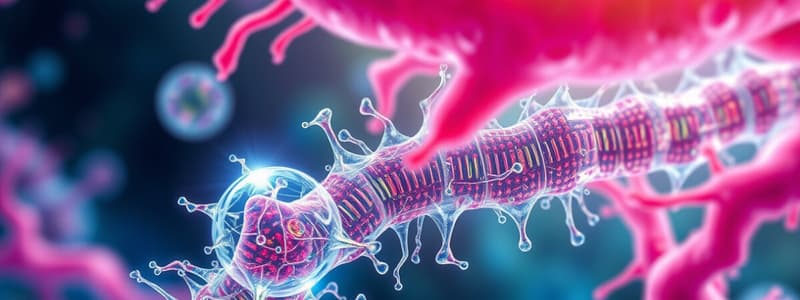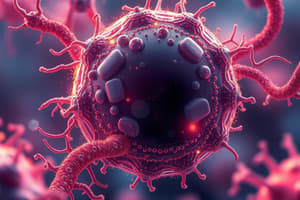Podcast
Questions and Answers
Which of the following are processes of life?
Which of the following are processes of life?
- Reproduction (correct)
- Communication
- Metabolism (correct)
- Growth (correct)
What kind of cell lacks a nucleus?
What kind of cell lacks a nucleus?
Prokaryote
What kind of cell has a nucleus?
What kind of cell has a nucleus?
Eukaryote
What are specialized structures within a cell that carry out its functions called?
What are specialized structures within a cell that carry out its functions called?
What is the term for a gel-like substance that surrounds the outside of a cell?
What is the term for a gel-like substance that surrounds the outside of a cell?
What type of glycocalyx is firmly attached to a cell surface?
What type of glycocalyx is firmly attached to a cell surface?
What is a loose, water-soluble glycocalyx called?
What is a loose, water-soluble glycocalyx called?
What does 'desiccation' refer to?
What does 'desiccation' refer to?
What are long structures that propel a cell through its environment called?
What are long structures that propel a cell through its environment called?
What are the three parts of a flagellum?
What are the three parts of a flagellum?
What type of flagella covers the surface of a cell?
What type of flagella covers the surface of a cell?
What term describes movement in response to stimuli?
What term describes movement in response to stimuli?
What is the function of fimbriae?
What is the function of fimbriae?
What term describes slimy masses of microbes adhering to a substrate?
What term describes slimy masses of microbes adhering to a substrate?
What is the primary function of ribosomes?
What is the primary function of ribosomes?
What are the types of bacterial cell walls?
What are the types of bacterial cell walls?
Match the following terms with their definitions:
Match the following terms with their definitions:
What is the function of a cell wall?
What is the function of a cell wall?
What is the term for the movement of water across a selectively permeable membrane?
What is the term for the movement of water across a selectively permeable membrane?
Flashcards are hidden until you start studying
Study Notes
Processes of Life
- Four fundamental processes: growth, reproduction, responsiveness, metabolism.
Cell Types
- Prokaryotes: Cells lacking a nucleus.
- Eukaryotes: Cells containing a nucleus.
Cellular Structures
- Organelles: Specialized structures functioning like tiny organs within cells.
- Glycocalyx: Gelatinous, sticky covering surrounding a cell.
- Capsule: A firm glycocalyx in bacteria composed of organic chemicals.
- Slime Layer: A loosely attached, water-soluble glycocalyx that protects against desiccation.
Cell Motility
- Flagella: Long structures extending from the cell surface, enabling propulsion.
- Three Flagella Parts: Filament, hook, basal body.
- Types of Flagella:
- Peritrichous: Cover the entire cell surface.
- Polar: Located at one or both ends of the cell.
- Endoflagella: Tightly spiraled around the cell, not protruding.
Directional Movements
- Taxis: Movement in response to environmental stimuli.
- Phototaxis: Movement towards or away from light.
- Chemotaxis: Movement towards or away from a chemical stimulus.
Adherence Structures
- Fimbriae: Bristle-like projections enabling adhesion to surfaces or each other.
- Biofilms: Slimy microbial masses adhering via fimbriae and glycocalyces.
- Pili: Tubules made of pilin, longer than fimbriae but shorter than flagella.
Cell Wall Functions
- Provides structural integrity and shape.
- Protects against osmotic pressure.
- Assists in cell-to-cell attachment.
- Resists antimicrobial agents.
Bacterial Cell Shapes
- Cocci: Spherical cells, found singly or in clusters.
- Bacilli: Rod-shaped cells, found singly or in chains.
Peptidoglycan Structure
- Composed of N-acetylglucosamine (NAG) and N-acetylmuramic acid (NAM).
- Glycan portion: Chains of NAG and NAM linked covalently.
- Peptido portion: Crossbridges made of amino acids connecting NAG and NAM chains.
Bacterial Cell Wall Types
- Two main types: Gram-positive and Gram-negative.
Cell Membrane Characteristics
- Cytoplasmic Membrane: Also known as the cell or plasma membrane, located beneath the glycocalyx and cell wall.
- Phospholipid Bilayer: Fundamental structure of the cytoplasmic membrane.
- Fluid Mosaic Model: Describes membrane structure, highlighting protein and lipid mobility.
Membrane Functions
- Regulates substance passage.
- Produces energy storage molecules.
- Captures light energy in photosynthetic bacteria.
- Selectively permeable: Allows specific substances to cross.
Chemical Gradients
- Concentration Gradient: Difference in chemical concentration across the membrane.
- Electrical Gradient: Voltage difference across the membrane.
Movement Mechanisms
- Diffusion: Movement from high to low concentration areas.
- Facilitated Diffusion: Proteins aiding the diffusion of specific molecules.
- Osmosis: Water diffusion across a selectively permeable membrane.
Solution Concentrations
- Isotonic: Equal solute concentrations on both sides of the membrane.
- Hypertonic: Higher solute concentration outside the cell.
- Hypotonic: Lower solute concentration outside the cell.
Active Transport Mechanisms
- Three types:
- Uniport: One substance at a time.
- Antiport: Two substances in opposite directions.
- Synport: Two substances in the same direction.
- Group Translocation: Active transport that chemically alters the substance during movement.
Cytoplasm and Organelles
- Cytoplasm: Gel-like material within cells.
- Cytosol: Liquid portion of the cytoplasm.
- Nucleoid: Region in prokaryotes containing DNA.
- Inclusions: Storage deposits within bacterial cytosol (lipids, starch, nitrogen, phosphorus, sulfur).
Energy Storage
- Bacteria store carbon and energy in glycogen or polyhydroxybutyrate.
Endospores
- Structures produced by some bacteria to survive extreme conditions.
Ribosomes and Cytoskeleton
- Ribosomes: Sites for protein synthesis within cells.
- Cytoskeleton: Internal fiber network providing cell shape.
Eukaryotic Glycocalyces Functions
- Anchors animal cells together.
- Strengthens the cell's surface.
- Provides protection against dehydration.
- Facilitates cell recognition and communication.
Membrane Rafts
- Complex lipid-protein assemblies for signaling, protein sorting, and some cell movements.
Endocytosis
- Active transport mechanism where pseudopodia engulf substances.
- Types:
- Phagocytosis: Solid material intake.
- Pinocytosis: Liquid material intake.
Exocytosis
- Process enabling substances to be expelled from the cell, reversing endocytosis.
Studying That Suits You
Use AI to generate personalized quizzes and flashcards to suit your learning preferences.




